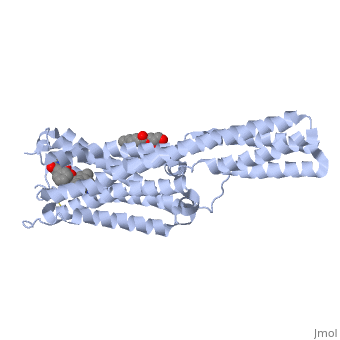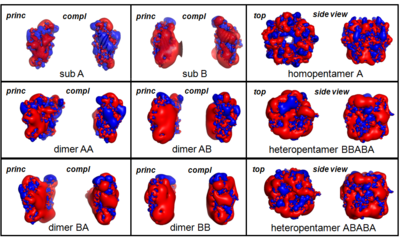Function
5-hydroxytryptamine (5-HT), Serotonin receptors are found on the membrane of neurons in the central nervous system and peripheral nervous system. These receptors allow for the body to respond to serotonin and regulate many biological pathways. Serotonin, also known as 5 hydroxytryptamine, is an endogenous neurotransmitter made from tryptophan and is largely found in the gastrointestinal tract. It is known to regulate mood, appetite, digestion, circadian rhythm, learning and internal temperature regulation. It is can be an inhibitory or excitatory neurotransmitter that is released into the synaptic space and can bind to receptors on the postsynaptic neuron or be taken back up into the presynaptic neuron via Serotonin re-uptake transporters.[1] 5-HT receptors are classified into 7 different subfamilies (5-HT1, 5-HT2, 5-HT3, etc.) by signaling mechanisms and homology of structure. All 5-HT receptors are known to have G-protein linked pathways except for the 5-HT3 receptor which acts as an ion channel. [2]
There are several subtypes of 5-HT receptors, each with its unique properties and distribution in different tissues and organs. These subtypes are classified based on their molecular structure and signaling mechanisms. Currently, 14 subtypes of serotonin receptors have been identified and designated as 5-HT1 to 5-HT7, with additional subtypes denoted by alphabetical suffixes.
The various subtypes of 5-HT receptors mediate diverse effects of serotonin throughout the body. They are widely distributed in the central nervous system (CNS), as well as in peripheral tissues, such as the cardiovascular, gastrointestinal, and immune systems.
The activation of 5-HT receptors by serotonin triggers intracellular signaling pathways that regulate neuronal excitability, neurotransmitter release, mood, cognition, sleep, appetite, pain perception, and various other physiological and behavioral functions. The different subtypes of 5-HT receptors have distinct effects and functions, and they can exert both inhibitory and excitatory effects on neuronal activity.
Selective targeting of specific 5-HT receptor subtypes has been a focus in the development of medications for various conditions, including depression, anxiety disorders, schizophrenia, migraine, and gastrointestinal disorders. Modulating the activity of these receptors can lead to therapeutic effects by affecting serotonin signaling pathways.
Overall, the 5-hydroxytryptamine receptors, or serotonin receptors, play crucial roles in regulating numerous physiological and behavioral processes throughout the body. Understanding their functions and signaling mechanisms is essential for advancing our knowledge of serotonin-related disorders and developing targeted therapies.
Structural highlights/Specific Function of 5-HT1B
The couples to G-protein alpha subunits Gi and Go. In the central nervous system, this receptor is an inhibitory presynaptic receptor that can alter the release of serotonin, as well as other neurotransmitters, from the presynaptic neuron. The structure of this receptor includes . of 5-HT1B is close to the ligand binding pocket suggesting some interaction with its ligand. , also called the orthosteric binding pocket, is characterized as a cavity formed from residues of the 3rd, 5th, 6th, and 7th alpha helices and the 2nd extracellular loop (ECL2). [2]
Structural highlights/Specific Function of 5-HT2B
The is important in utilizing serotonin signals to encourage proper development and continuing function of the cardiovascular system. Overexpression of 5-HT2B has been linked to congestive heart failure.[3] 5-HT2B utilizes the alpha Gq protein pathway which triggers intracellular cGMP production through activation of nictric-oxidase synthase (NOS).[4] This receptor is also known for being the target of the drug LSD, which is similar in structure to serotonin. [5] The structure of this receptor is much like that of 5-HT1B, however significant differences are seen in their binding pockets. The pocket of 5-HT1B is much broader than , due to a 3 Å shift of the top of helix V. Perhaps this difference highlights a variation in serotonin affinity between the two families. The similar characteristics of the 5-HT1B and 5-HT2B receptor families consist of 7 alpha helices and the N-terminus sticking out into extracellular space. [2]
Structural highlights/Specific Function of 5-HT2C
Serotonin 5-HT2C receptors are targets for treatment of depressive and anxious states[6]. 5-HT2C receptors may be involved in the effects of corticosterone-induced hyperphagia[7].
Structural highlights/Specific Function of 5-HT3
is a pentameric cation-selective ion channel and plays a role in neuronal excitation to release neurotransmitters from the postsynaptic neuron. Opening of the cation channel causes an influx of sodium and calcium through the receptor pore leading to a membrane depolarization. Five receptor subunits, A to E, have been found in humans but only subunits A and B have been found in rodents. When experimentally expressed in a host, the 5-HT3 receptor is comprised of either A or AB subunits which can result in a homopentameric receptor or a heteropentameric receptor respectively. The A and B subunits are found throughout the brain in areas such as the hippocampus and amygdala. 5-HT3 is a transmembrane channel that is stimulated to open state by the interaction of the receptor with serotonin in the extracellular space.[8] The binding site is comprised of six loops from two adjacent subunits in the extracellular N-terminal domain. Loops A, B and C form the principal subunit and contain the N128, W183 and Y234. Loops D, E and F form the complementary subunit of the binding site and contain the important side chains W90, Y143 and W195. The transmembrane region is comprised of multiple alpha helical structures and mediates ion flow and ion specificity.[9]
For more details see 5-ht3a receptor and Ion channels.
The extracellular subunit interface of the 5-HT3 receptors: a computational alanine scanning mutagenesis study[10]
The serotonin type-3 receptor (5-HT3-R) is a cation selective transmembrane protein channel that belongs to the Cys–loop Ligand-Gated Ion Channel (LGIC) superfamily (http://www.ebi.ac.uk/compneur-srv/LGICdb/LGICdb.php), which also includes receptors for nicotinic acetylcholine (, PDB code 2bg9), γ-aminobutyric acid and glycine. 5-HT3-R is involved in signal transmission in the central and peripheral nervous system and its malfunctioning leads to neurodegenerative and psychiatric diseases, therefore it is an important target for drug design research. A few drugs active against 5-HT3-R are already on the market, such as, for example, palonosetron (http://en.wikipedia.org/wiki/Palonosetron) and granisetron (http://en.wikipedia.org/wiki/Granisetron).
The 5-HT3R is made of five monomers assembled in a to form an ion channel permeable to small ions (Na+, K+); each subunit contains three domains: an (shown on the example of nAChR, 2bg9). To date, five different 5-HT3-R subunits have been identified, the 5-HT3 A, B, C, D and E; however, only subunits A and B have been extensively characterised experimentally. The of nAChR is located at the extracellular region, at the interface between two monomers (α-γ and α-δ; 2 identical α monomers, chains A and D, are colored in same color - lavender), called the principal and the complementary subunits.
The 3D structure of 5-HT3-R has not been experimentally solved yet; however, it has been obtained computationally by means of homology modelling techniques. (http://salilab.org/modeller/)
Thus, the are modelled by homology with the 3D structure of the nAChR subunit A (2bg9-A) and are used to assemble receptor structures as pseudo-symmetric pentamers made either of or of in a still debated arrangement.[11] Subunits A and B are colored in magenta and red, respectively.
A complete characterization of the extracellular moiety of the (AA dimer is shown, principal subunit is colored in cyan and complementary is in blue, is obtained by the Computational Alanine Scanning Mutagenesis (CASM) approach [12], which simulates the substitution, one by one, of all the amino acid residues at the subunit-subunit interfaces with an Ala, thus to assess the interface binding contribution of single residue side-chains. The are classified as “hot spots” that stabilize the interface by more than 4 kcal/mol and “warm spots” that contribute to interface stabilization by more than 2 kcal/mol. Interface residues are shown in spacefill representation, hot spot residues are colored in red and warm spots residues are are in orange.
From this analysis the located at the interface core and formed by residues W178 (principal subunit), Y68, Y83, W85 and Y148 (complementary subunit) is highlighted.[13] In addition, two important groups of interface residues are probably involved in the coupling of and binding to channel activation/inactivation: W116-H180-L179-W178-E124-F125 (principal subunit) and Y136-Y138-Y148-W85-(P150) (complementary subunit), where W178 and Y148 appear to be critical residues for the binding/activation mechanism. Finally, the (principal subunit of AA is colored in cyan, principal subunit BB is colored in darkmagenta, complementary subunit AA is in blue and complementary subunit BB is in magenta) shows differences which could explain the reasons why the homopentamer 5-HT3B-R, if expressed, is not functional (see also image below).[14]
5HT-2B receptor agonists: Lysergic Acid Diethylamide (LSD)
Lysergic Acid Diethylamide, more commonly known as LSD, is a highly potent hallucinogen and is derived from ergotamine, an ergopeptine whose structural skeleton is contained in a diverse range of alkaloids. LSD acts as a non-selective 5-HT receptor agonist, meaning it can bind with equal affinity to two or more sub-types of receptors. LSD actively binds in the to both the 5-HT1B and 5HT-2B receptors, suggesting a similar chemical structure and function between the two receptor families. The docking is stabilized by all the same residues involved in normal binding in the orthosteric pocket. Hydrogen bonding between the amino group of the 5-membered ring of LSD and the T140 residue of the 5-HT2B receptor, as well as hydrogen bonding between D135 and the other ergoline amino group stabilize the LSD in a similar fashion that 5-HT would bind to the receptor. [2]
5-HT3 receptor antagonists
5-HT3 antagonists have been predominantly used as an antiemetic drug in relieving treating symptoms such as nausea and vomiting for a cancer patient receiving chemotherapy. Three high affinity antagonist often used are granisetron, tropisteron and ondansetron. The common structure shared among 5-HT3 antagonists contains an amine with an aromatic ring system and a carbonyl group. [9] Experimental homology modeling suggests that 5-HT3 antagonists have aromatic rings that form π-π interactions with the tyrosine, Y143 and tryptophan, W183, side chains of the 5-HT3 receptor. It is also theorized that the antagonist contain carbonyl groups which accept hydrogen bonds from serine, S227, side chain of the 5-HT3 receptor.[15] During the binding of granisteron to the 5-HT3 receptor, the aromatic rings sit within W183 and Y234 and an azabicyclic ring within W90 and F226 of the binding pocket.[9] Once a 5-HT3 antagonist has bound to a 5-HT3 receptor, serotonin binding is inhibited.[16]
For more details see 5-ht3a receptor.
3D structures of 5-hydroxytryptamine receptor
5-hydroxytryptamine receptor 3D structures
See also


